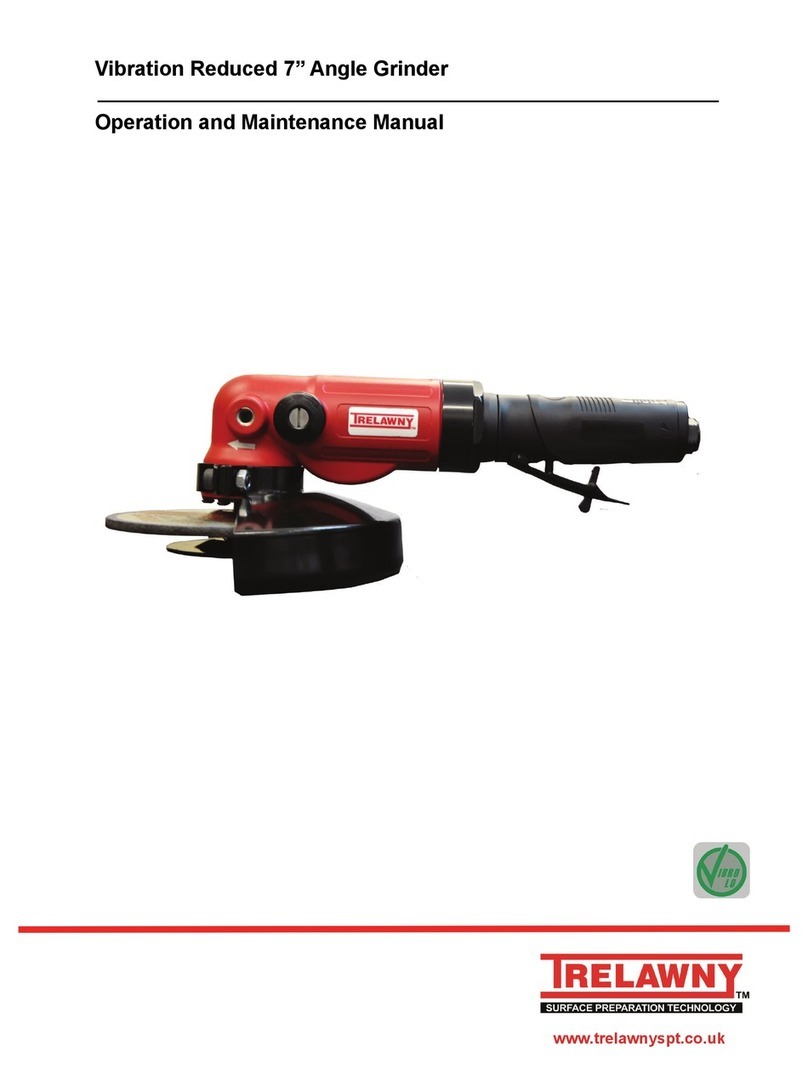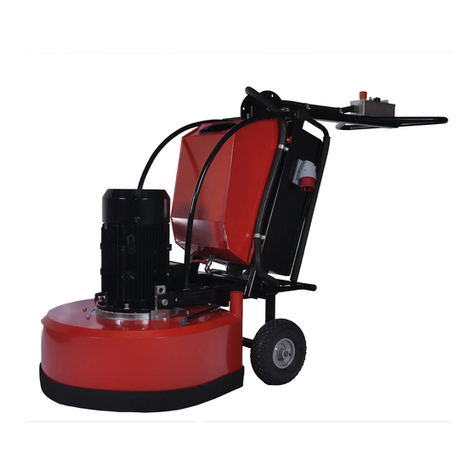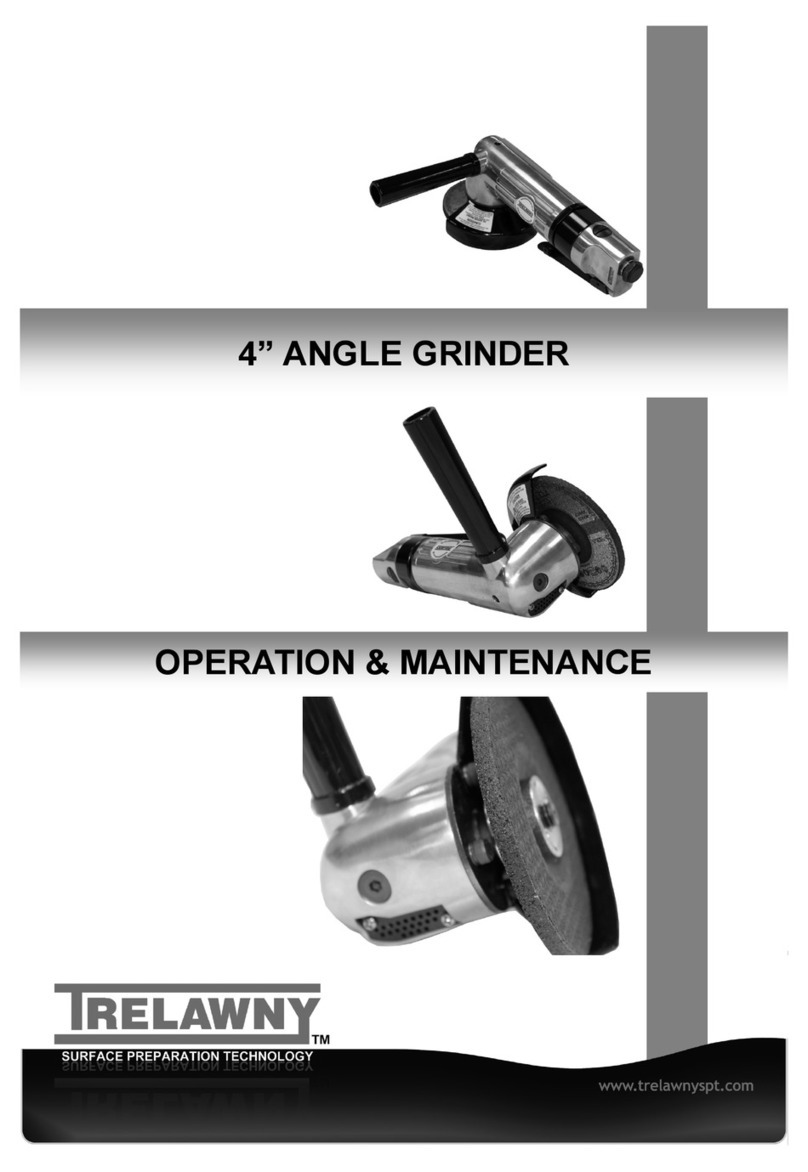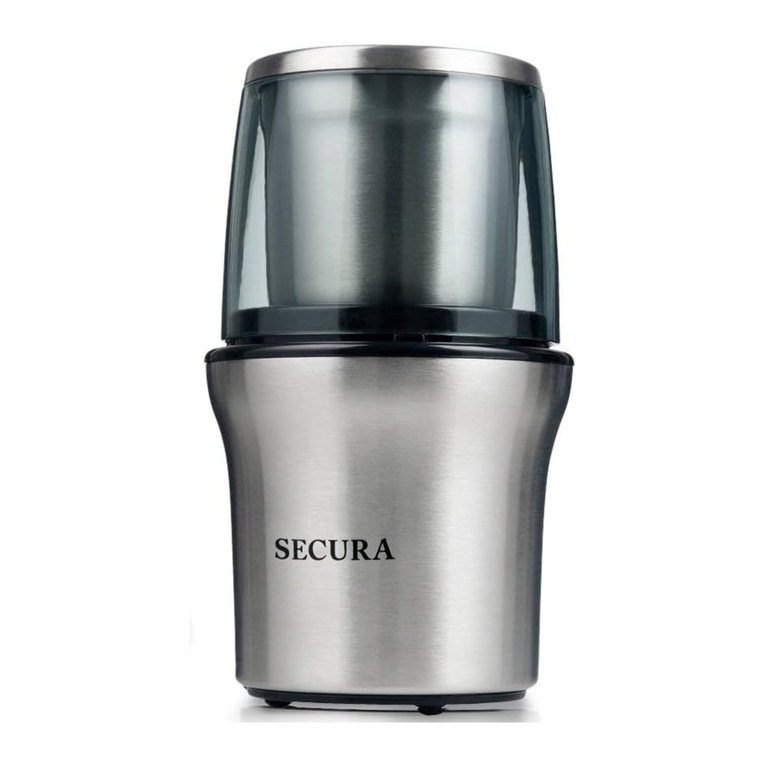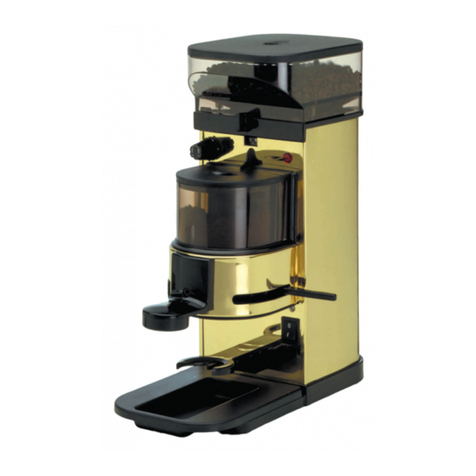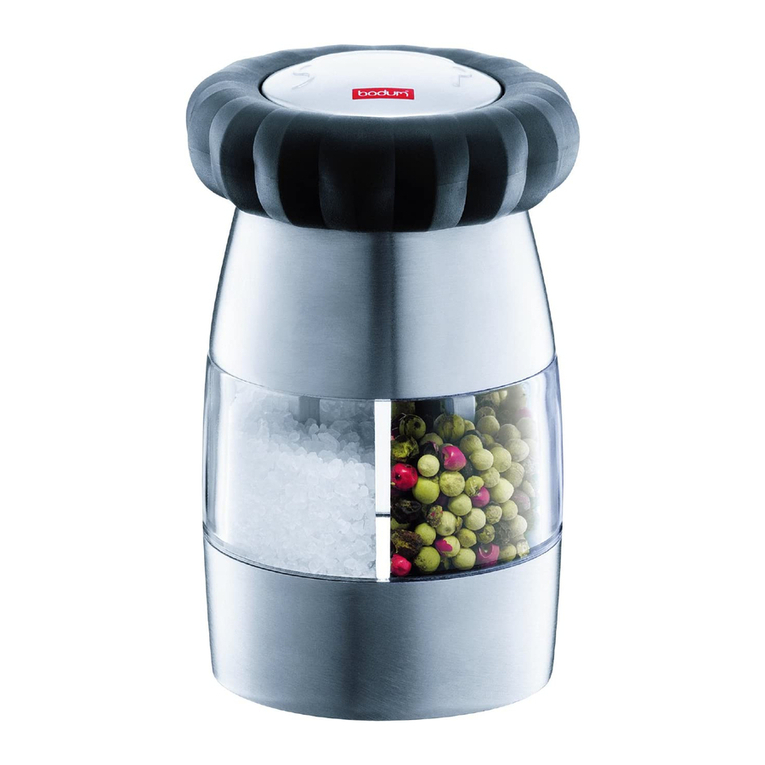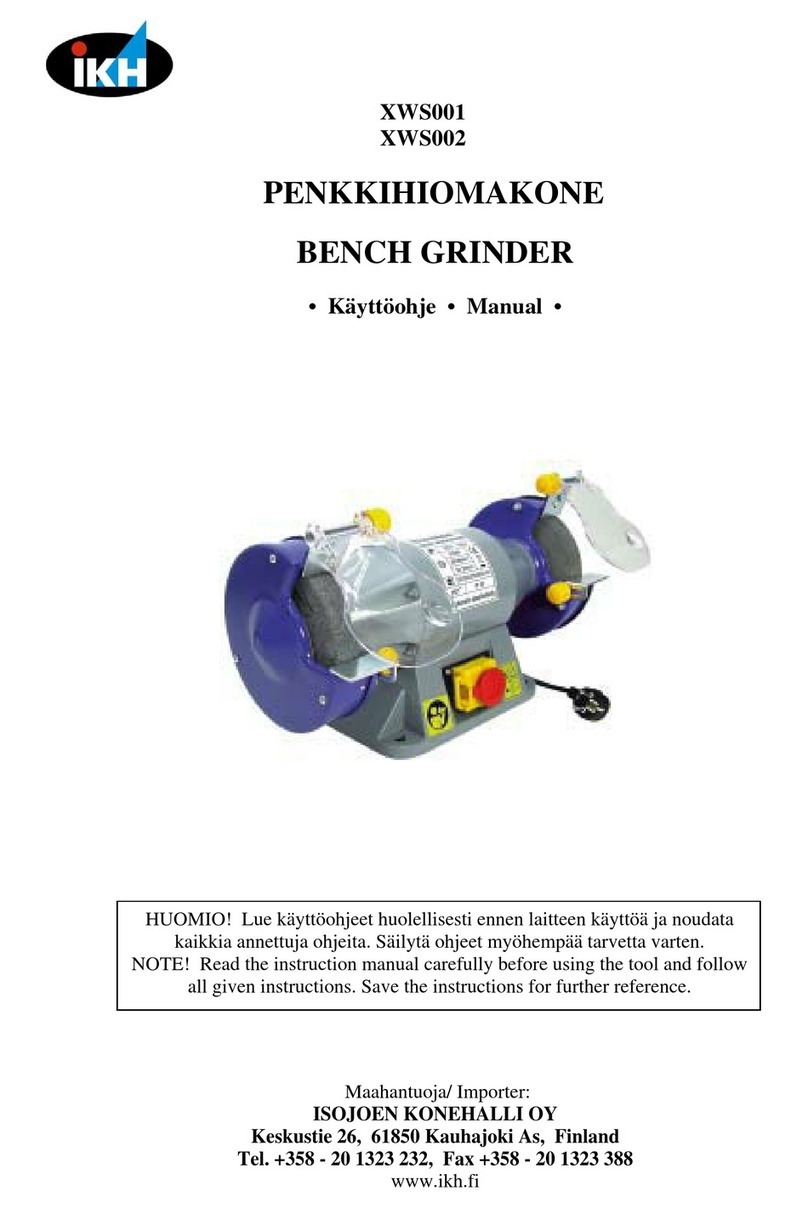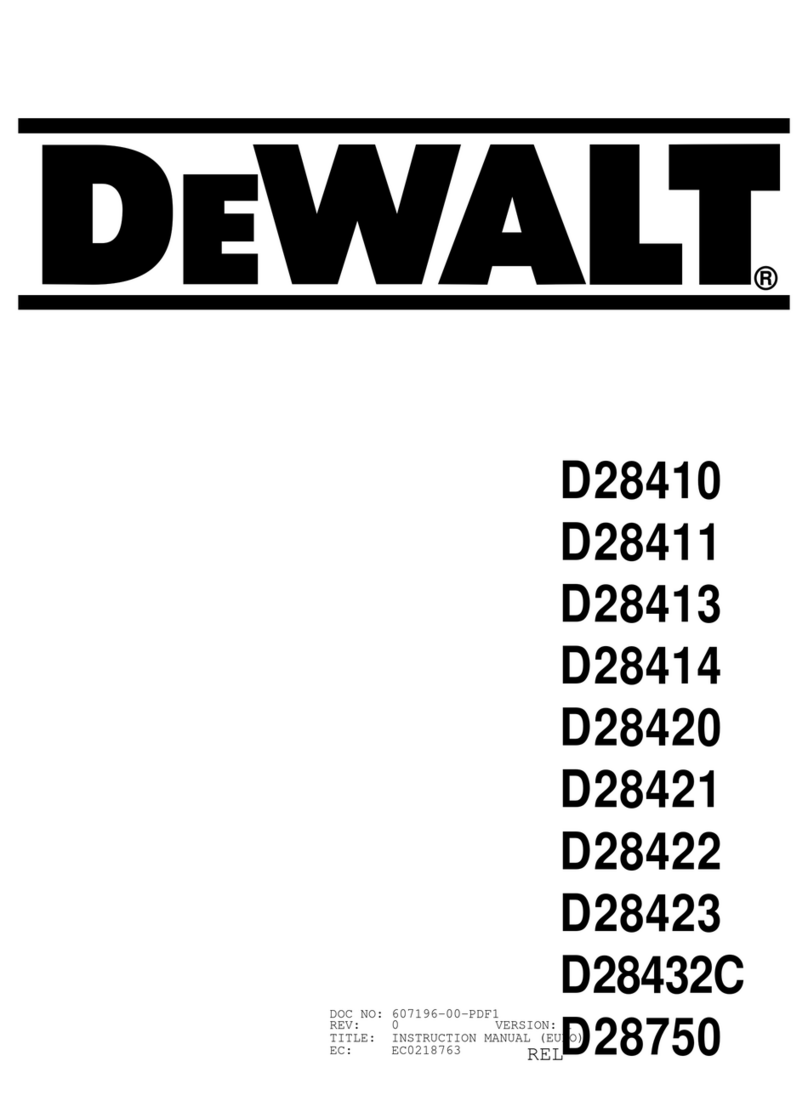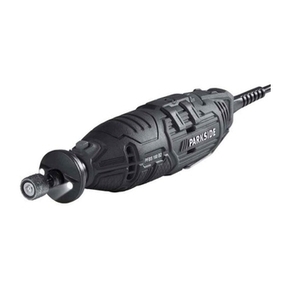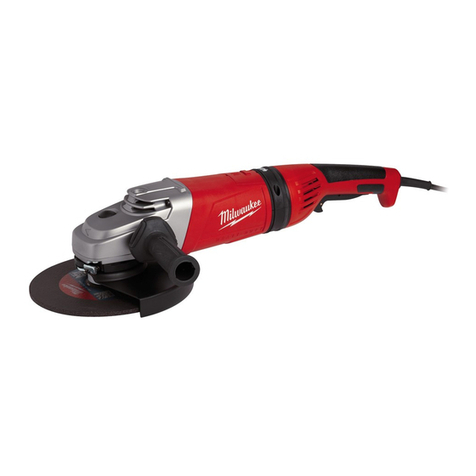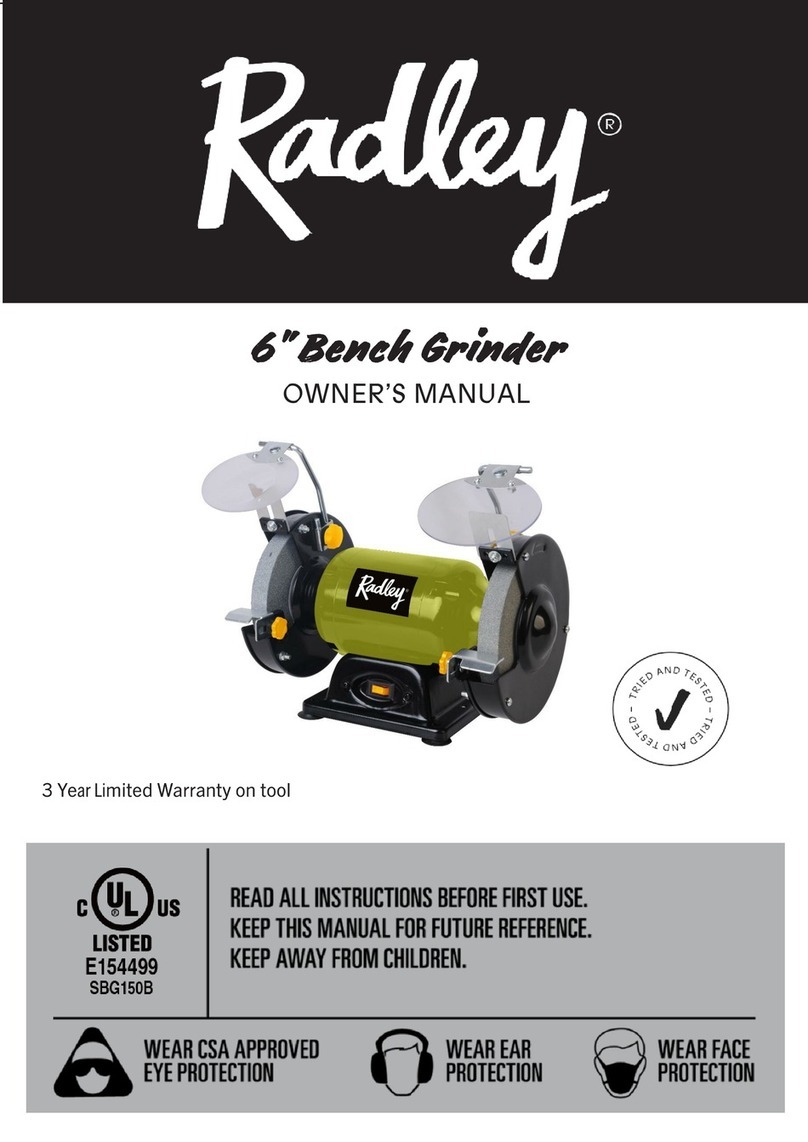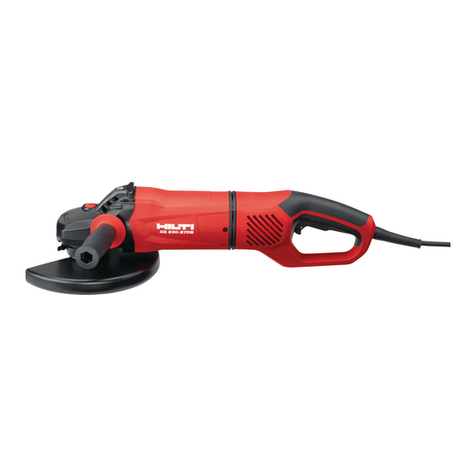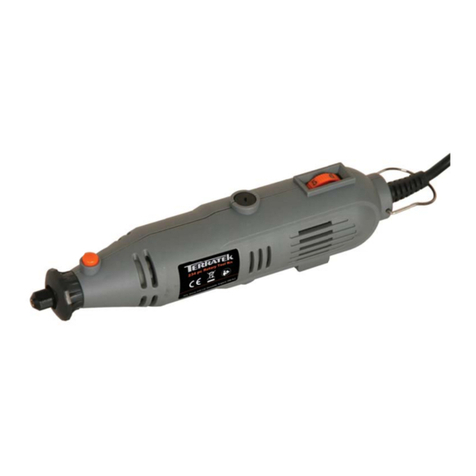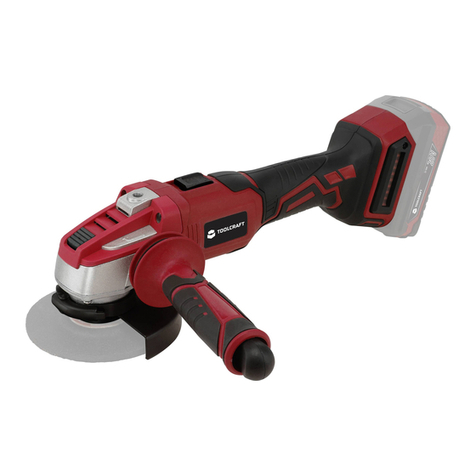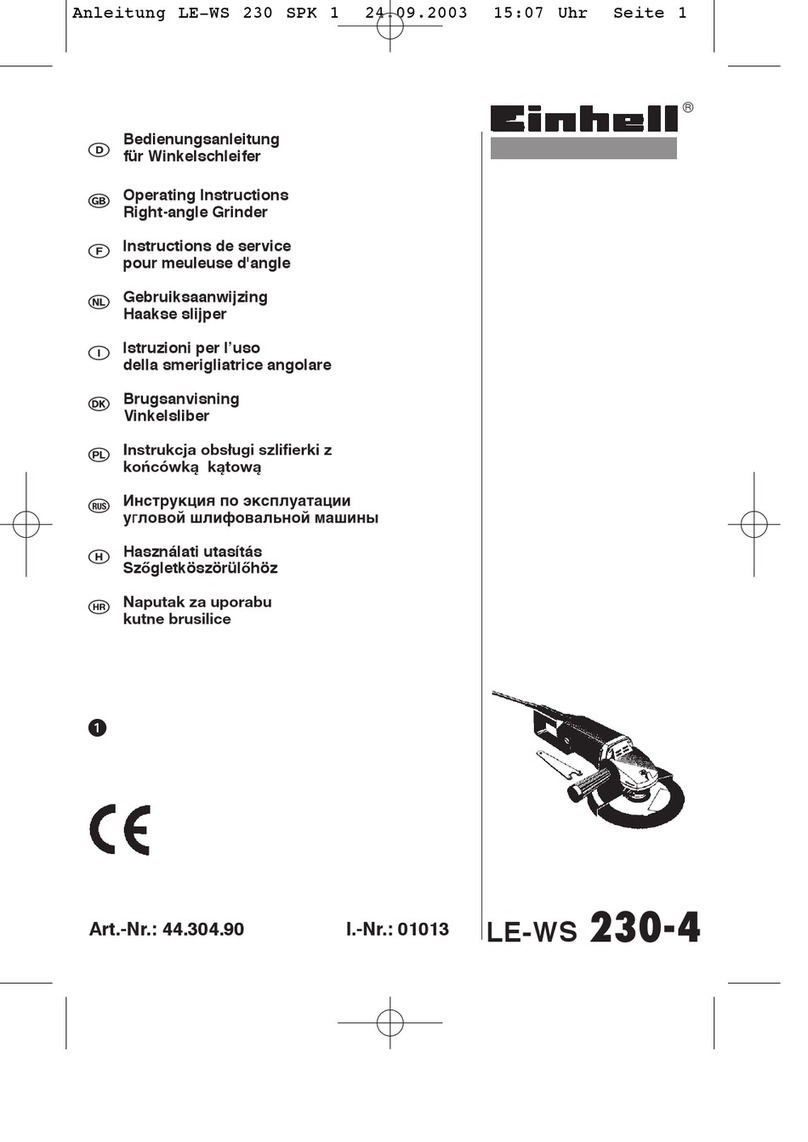Trelawny 735.7072 User manual

4’’ Vibration Reduced Angle Grinder
Operation and Maintenance Manual
www.trelawnyspt.co.uk



OPERATION
Foreword
Thank you for your purchase of the
TRELAWNY 4” Vibro-Lo Angle
Grinder.
This manual contains the necessary
maintenance information for you to
ensure proper operation and care for
this machine.
It is essential for you to read
through this manual thoroughly.
In the unlikely event that you
experience problems with your
4” VL Angle Grinder, please do not
hesitate to contact your local
Trelawny dealer or agent. We
always welcome feedback and
co mm ent s f ro m ou r val ue d
customers.
Safety Precautions
WEAR SAFETY BOOTS, FACE
M A S K , S H A T T E R P R O O F
GLASSES, HELMET, GLOVES and
any other personal protective
equipment required for the working
conditions. Avoid loose clothing; this
may become trapped in moving
parts and cause serious injury.
A I R M O T O R S A R E N O T
ELECTRICALLY INSULATED.
ENSURE THAT HANDS and
clothing are kept away from rotating
parts.
ONLY YOUR SUPERVISOR OR
AUTHORISED MAINTENANCE
ENGINEER should adjust the speed
control setting within the air motor;
although this has been set to the
optimum speed during manufacture,
the speed should be checked on a
daily basis.
ENSURE THAT THE WORK PLACE
IS WELL VENTILATED. Avoid
o p e r a t i n g e n g i n e - p o w e r e d
compressors in an enclosed area,
since engine exhaust gases are
poisonous.
BE AWARE, when the angle grinder
is switched off, the work head will
continue to rotate briefly.
The grinder must never be used
without a wheel guard fitted.
The air supply should be lubricated. It is
strongly recommended that an air filter,
regulator, lubricator is used, this will
supply clean, lubricated air at the correct
pressure to the tool.
Details of such equipment can be
obtained from your supplier.
If such equipment is not used then the
tool should be lubricated by shutting off
the air supply to the tool, depressurising
the line by pressing the trigger on the
tool.
Disconnect the air line and pour into the
air intake a teaspoonful (5ml) of a
suitable pneumatic motor lubricating oil
preferably incorporating a rust inhibitor.
Reconnect tool to air supply and run tool
slowly for a few seconds to allow air to
circulate the oil. If tool is used frequently
lubricate on daily basis and if tool starts
to slow or lose power.
Putting into service
Remove plastic bung from air inlet
using a pair of pliers.
Use a clean lubricated air supply that
will give a measured air pressure to
the tool of 6.3bar (90psi).
It is recommended a air filter/regulator/
lubricator is used which can be
obtained from air tool supplier.
Recommended lubricants
Oil the tool daily during use. Put a few
drops of one of the following bio-
degradable air tool lubricants through
the air inlet.
SHELL Naturelle HF
CASTROL Carelube HTG 22
Always use clean oil from a sealed
container.
Risk of Hand-arm Vibration
injury
These tools may cause Hand-arm
Vibration Syndrome injury if their use
is not adequately managed.
We advise you to carry out a risk
assessment and to implement
measures such as; limiting exposure
time [i.e. actual trigger time, not total
time at work], job rotation, ensuring the
tools are used correctly.
Ensure the tools are maintained
according to our recommendations,
and ensuring that the operators wear
personal protective equipment [PPE]
particularly gloves and clothing to
keep them warm and dry.
Employers should consider setting up
a programme of health surveillance to
establish a benchmark for each
operator and to detect any early
symptoms of vibration injury.
We are not aware of any PPE that
provides protection against vibration
injury by attenuating vibration
emissions.
See ‘Specifications’ section for
vibration emission data.
Grinding Discs, Flap Wheels &
Applications
Grinding Discs
For use on steel.
Flap Wheel
For the removal aggressive removal of
paint and coatings and heavy rust from
steel work, leaving a bright finish on
steel work.
Wire Cup Brush
For the removal of light paint, other
coatings and rust from steel work.
Use of tool
This angle grinder is designed for use
with reinf orc e d resin bond ed
depressed centre grinding wheels that
have a permitted rotational speed in
excess of 10,000rpm.
The tool is designed for light grinding
and dressing of welds, etc, but not for
cutting off.

OPERATION
Pre-Start Check (Daily)
Check all bolts and screws for
tightness.
Ensure that all fittings are secure.
Check condition of hub or drum
assembly and replace flaps, cutters or
axles if required.
The air motor speed is preset at the
factory to 10,000 rpm (free running).
Always clear the air hose before
connection to the machine.
E n s u r e t h a t n o m o i s t u r e
(condensation) is present in the air
hose.
Check the security of all hoses clamps
and fittings, and that the air pressure is
correct at 90psi (6.2bar). The air motor
uses approximately 10cfm of air.
The Maximum air pressure is 100psi
(7bar) the air consumption will
increase as the air pressure rises.
It i s r e c o mm e n d e d t ha t th e
compressor is capable of supplying at
least 30cfm supply of free air (not
displaced, as given by some
compressor manufactures).
In particularly cold weather it is
recommended that a proprietary anti-
freeze lubricating oil is used.
Operating
With the grinder correctly connected to
the air supply, check the speed of the
grinder with an inlet pressure of 100
psi/7.0 bar measured at the tool inlet.
Check with a calibrated tachometer.
Check that the guard is in position and
securely fixed.
Check that the grinding wheel is of
correct dimensions, is not cracked or
chipped and has a permitted speed
rating higher than the maximum
permissible running speed of the
grinder which is 10,000 RPM.
Check that item disc receiver is
screwed tightly to the shaft and locates
the bore of the grinding wheel on the
spigot of the disc receiver and screw on
disc nut item (40) using the spanners
provided.
Do not over tighten as this could crack
the wheel. It should be tight enough to
prevent wheel spin off when the air
supply is shut off.
When first starting the grinder with a
new or changed wheel fitted, the
grinder should first be started in a
protected area, i.e. such as under a
heavy bench well away from other
persons and run for one minute.
This will provide protection if the wheel
should break because of a fault that
was not visibly detected.
Always use eye protection and wear
protective gloves if there are sharp
edges in the working area.
The tool and the grinding process can
create a noise level such that ear
protectors should be worn.
If the grinding process creates dust
then use a suitable breathing mask.
Check that the material being worked
will not cause harmful dust or fumes. If
this is so then special breathing
apparatus may be required. Seek
advice before starting work.
If the grinder vibrates when first fitting
the wheel or during use, remove from
service immediately and arrange for the
fault to be corrected before continuing
to use.
Do not apply excessive pressure as this
will reduce the cutting efficiency.
Apply light loads and allow the wheel to
cut.
Handle the grinder with care.
If the grinder is dropped, carefully
examine the wheel for damage and
replace if necessary.
Start the machine as if for the first time
of fitting a wheel, i.e. under a bench.
Make sure the object to be worked on is
in a securely fixed position.
Dismantling & Assembly
Instructions
The dismantling and assembly will
require some special tools, which can
be produced by any machine shop.
Special tools required are:
1 x 5.0mm x 50mm bar.
1 x 7.75mm x 50mm bar.
1 x Ø8.5mm x 50mm bar.
1 x Ø9.2mm x 150mm bar.
1 x Ø11.8mm x 50mm bar.
1 x Ø10mm Ø6.2mm bore x 25mm
long tube.
2 x Ø15.0mm tubes x Ø8.2 bore x
25mm long.
1 x Ø21.5mm tube x Ø16.0mm bore x
50mm long.
1 x Ø21.9mm x 50mm tube x Ø14mm
bore.
Using these tools during assembly will
prevent damage to the bearings.
Disconnect tool from air supply.
Remove the side handle (54) by
unscrewing anti-clockwise from the
body (1).
Dismantling the Gear housing
Press in and hold locking button (60) to
lock the spindle Insert spanner (55) into
the holes in disc nut (40), unscrew disc
nut.
Take off grinding disc and disc receiver
(38), remove circlip (71) and take off
disc cover, and remove indexing clip
(69) and spring (68).
Unscrew and remove the set screw (61)
from the housing using a 2.5mm Allen
key.
The spindle stop button can now be
removed as an assembly comprising of
components 56, 57, 58, 59 and 60.
Use a 4mm Allen key and remove the
4 x M5 screws (43) from the gear
housing (36).
Pull out the drive shaft assembly from
gear housing (23).
Remove spacer (26), taking note of its
orientation.

Remove the Screw (27) along with
sealing O’Ring (7) using a Philips screw
driver.
Remove the Steady (80) and the
washer (81).
Remove the felt oiler (79).
Unscrew and remove the 4 x M5
caphead screws (25) using a 4mm
Allen key along with their spring
washers (24).
Separate the Gear Housing (23) from
the Motor Housing (1).
In the Gear Housing is a bevelled gear
(22) held in a bearing (20), push the
gear and bearing out from the inside of
the Gear Housing.
Support the bearing with the bevelled
gear below and using the Ø11.8mm
bar, press the gear out of the bearing.
Carefully remove the gasket (21) from
the Motor Housing.
Pull the Rotor assembly (15) out of the
Motor Housing (1) comprising of
components (13), (19), (3), (18), (39),
(17), (16), (15), (14), (13), (42), (41),
(45), (46), (47) and (48).
Dismantling the Motor housing
In the bottom of the Motor Housing (1)
is the Inlet Guide (44), pull this out
along with the O’Ring (49).
Using a pin punch drift out the spring
pin (2) that retains the Throttle Lever (4)
assembly.
Grip the Throttle Pin (5) and pull out of
the Motor Housing.
Unscrew Air inlet using a 21mm
spanner and remove the Exhaust
diffuser (53) and its O’Ring (86).
Remove the Spring (8) and the Valve
stem (10).
At the bottom of the brass insert in the
housing is the Valve Seat (6) this can
be pushed out using the Ø9.2mm bar
from the gear head end of the housing.
Dismantling the Spindle
assembly
Support the bearing (28) with the
spindle assembly below, use a
Ø5.0mm bar press out the spindle
through the bearing.
Using a small pair of external circlip
pliers remove the Retaining Ring (29).
Remove the Wavy Washer (31).
Support the Bevel Gear and press out
(30), remove the Key (34) and the
Spacer (35).
Dismantling this next item may require
a new bearing fitting on reassembly.
Support the Bearing (32) and press the
Spindle out (33).
Dismantling the Rotor
assembly
Be aware that dismantling the rotor will
require new bearings as these are very
likely to become damaged during the
dismantling process.
Remove the spring pin (17) Using a pair
of pliers.
Grasp the Cylinder (18) in the hand and
tap the splined end of the Rotor using a
small soft faced hammer.
The Front End Plate (19) with its
Bearing (13) and Cylinder (18) should
then come apart, take care not to loose
the 4 x Rotor Blades (16).
At the other end of the Rotor is the
governor, this is retained by 2 x Spring
Pins (48), use a small pin punch to
remove the pins, taking care not to
loose any off the 6 x Pendulums (47).
The governor’s Plunger (12), Spring
(45) and the Adjust Nut (42) can be
removed if required but if stripped this
will require the motor speed resetting to
the correct revolutions per minute using
an accurate revolution counter.
This will involve stripping the motor a
adjusting many times until the
revolutions are correct.
Press out the Rotor (15) from the
Bearing (13) fitted inside the rear plate
(14).
Support the Front Plate (19) with the oil
groove upper most and ensuring there
is enough clearance for the bearing to
pass.
Using a 8.20mm diameter bar, press
out the bearing (13).
Support the bearing Rear Plate (14)
with the rotor below and using a
7.75mm diameter bar press out the
rotor.
Support the Rear Plate (19) with the oil
groove upper most and ensuring there
is enough clearance for the bearing to
pass. Using a 7.75mm diameter bar,
press out the bearing (13).
ASSEMBLY
Ensure that all components are clean
and that all internal components are
liberally coated in the recommended air
tool oil.
Place the Rear Plate (14) on a flat
surface with a sheet of paper between
to prevent damage to the plate surface.
Using the flat ended 21.9mm diameter
tube, press in the Bearing (13) to the
bottom of the housing.
Ensure that the bearing turns smoothly
and does not feel rough or gritty.
Do the same for the Front End Plate
(19) and its Bearing (13).
Insert a new O’Ring (49) into its recess
in the Inlet Guide (44).
Assembling the Rotor
Using 1 x Ø15mm diameter tubes,
place the Front End Plate (19)
centrally over one of the tubes for the
base, with the oil groove uppermost.
Insert the rotor with the splined end
into the bearing centre and lightly
press down until solid.
Check that both bearings rotate
smoothly.
Using a small hammer lightly tap the
Spring Pin (17) into the Cylinder (18)
location hole, about 6mm should
remain proud.
Using the 15mm diameter tube for the
base again, place the Rotor assembly
with the threaded end uppermost into
the tube.

Insert the rotor Blades, angled edge
first into each groove with a coating of
oil to keep them in place (do not use
grease).
Place the Cylinder (18) centrally over
the Rotor assembly locating the
shorter spring pin in its location hole in
the Front End Plate (19).
With the oil grooves of the Rear Plate
(14) assembly facing downwards,
place onto the threaded end of the
Rotor and using the second Ø15mm
tube on the centre race of the bearing.
Ensure that the long spring pin (17) is
aligned with its location hole in the
Rear Plate and lightly press down until
there is no visible gap between the
Cylinder and Rear Plate.
Check that assembly rotates smoothly.
If stripped reassemble the Governor,
Insert the threaded end of the Plunger
(12) into the Governor (slotted side).
Fit the Spring (45) and the Adjust Nut
(42).
Holding the Plunger tighten the
Adjuster Nut until the end of the nut to
face of the Governor measures 6mm,
which will give a safe starting point.
Attach the three Pendulums to either
side of the Governor, retain using the
two spring pins (48), tap in with small
hammer.
Screw the Governor assembly onto the
threaded end of the motor assembly,
this is a left hand thread.
Place the splined end of the motor
assembly into a soft jawed vice and
using a 13mm spanner on the spanner
flats, nip up the Governor.
Assembling the Spindle
Using the Ø21.5 tube as a base, place
the new bearing (32) centrally over the
tube. Insert the Spindle (33) threaded
end uppermost and press the spindle
onto the bearing until solid.
Place the Spacer (35) on the Bearing
and insert the Woodruff Key (34) into its
keyway and slide the Bevelled Gear
(30) onto the Spindle (33) with the teeth
facing away from the bearing.
Place the Wavy Washer (31) on the
Spindle followed by the Circlip (29),
pressing it down on it against the Wavy
Washer (31) to ensure that it is secure
in its groove.
Support the Spindle (33) under the
boss, threaded end down, use the
21.5mm tube as a base, and using the
Ø10mm tube over the Bearing (28)
press onto the Spindle until solid.
Assembling the Gear Housing
Place Spacer (81) into the Felt Oiler
(79), note that the hole is offset in the
oiler, the short side sits at the bottom of
the Gear Head.
Insert the Steady (80) into the Felt Oiler
Spacer (81) and p osition the
assembly’s hole directly over the hole
for the retaining Screw (27).
Insert retaining Screw (27) with it’s
O’Ring (7) but before tightening fully,
ensure that the Felt Oiler is fully seated,
then tighten.
Insert the Spacer (26) into it’s recess at
the bottom of the Gear Housing with the
domed side first.
Place several drops of gear oil onto
the Felt Oiler (79).
Also grease the Bevel Gear (30) with a
molybdenum or lithium based general
purpose grease and insert the Spindle
assembly into the Gear Housing (23).
Insert the Spindle Lock Button
assembly with the flat adjacent to the
retaining grub Screw threaded hole.
Insert the grub Screw (61) and tighten
the grub Screw using a 2.5mm Allen
key.
Fit the Bearing Cap (36) over the
spindle with the Spring’s (68) location
hole nearest the Spindle Lock Button
location hole.
Fit the 4 x M5 caphead Screws (43)
and tighten using a 4mm Allen key.
Assembling the Motor Housing
Insert the throttle Pin (5) into the Motor
Housing (1).
Locate the Throttle Lever assembly (4)
into position and secure with the Spring
Pin (2).
Using the Ø11.8mm bar push in the
Valve Seat (6) through the threaded
brass insert until seated.
When in the correct position the Valve
seat should be 25mm down the bore.
Insert the Valve Stem (10) long stem
first into the threaded brass insert,
followed by the Spring, small end first.
Fit the O’Ring (66) onto the Exhaust
Deflector (53) and push into the end of
the Motor Housing (1).
Carefully apply a small drop of
Loctite 243 to the thread of the
Air Inlet (3) only.
Do not allow Loctite onto the Spring
face of the Air Inlet (3) as this could
cause the motor to seize if it
contaminates internal components.
Fit the Air Inlet (3) into the Exhaust
Deflector (53) and tighten using a
21mm spanner.
Assembling the Grinder
Place the Inlet Guide (44) onto the
Governor end of the motor locating the
spring pin (17) into its slot in the Inlet
Guide.
Hold the assembly vertically by the
splines with the Inlet Guide (44) at the
top and carefully slide into the Motor
Housing (1).
The large diameter of the Front End
Plate (19) should now be almost level
with the Motor Housing face.
Put a smear of grease on the gasket
face to hold it in position and place the
ga s ket ( 2 1) o n t o t h e M o t o r
Housing (1).
Fit the Gear Housing (23) onto the
Motor Housing (1) by inserting the
splined shaft into the centre of the
bearing, you may have the turn the
spindle (33) to engage the splines into
the Bevel Gear (30).
Line up with the Screw holes and
insert the 4 x M5 Screws (25) with their
Spring Washers (24). Using a 4mm
Allen key, tighten all equally.
With the spindle facing upwards, insert
the spring (68) onto its recess.
Place the Lock Ring (69) into its
location, with the three recessed holes
on the tab facing towards the Bearing
Cap (36), followed by the Disc Cover
(37), and the Disc Spring (70).
Fit the Circlip (71) using circlip pliers,
ensuring its locates into the location
groove.
Check the spindle RPM and if
necessary strip down and adjust the
governor until 10,000rpm ±100rpm is
achieved.

TECHNICAL SPECIFICATIONS
Description 4” VL Air Grinder
Weight 1.70kg/3.75lbs
Spindle dia M10
Power requirements 10cfm@90psi (1/4”BSP inlet)
Maximum air pressure 7 bar (100psi)
No load RPM 10,000 RPM
Recommended hose bore - to a max length 10 metres 10mm (3/8”)
Vibration (AEQ)
Primary hand position (trigger position) 1.2 m/s2 (k)
Test method in accordance with ISO standards BS EN ISO 28927-12:2012
Noise
Noise LpA (Pressure Level) 83 dB(A)
Test methods in accordance with Pneurop test code PN8NTC1 & ISO 3744
MAINTENANCE
EXPLODED VIEW

SAFETY RULES
Safety Rules for a Grinder
1) Read all the instructions before using this tool. All operators must be fully trained in its use and aware of these safety rules.
2) Do not exceed the maximum working air pressure.
3) Use personal protective safety equipment.
5) If the tool appears to malfunction remove from use immediately and arrange for service and repair.
6) If the tool is used with a balancer or other support device ensure that it is fixed securely.
7) Always keep hands away from the working attachment fitted to the tool.
8) The tool is not electrically insulated. Never use the tool if there is any chance of it coming into contact with a live electrical
source.
9) Always when using the tool adopt a firm footing and/or position and grip the tool firmly to be able to counteract any forces
or reaction forces that may be generated whilst using the tool.
10) Use only correct spare parts. Do not improvise or make temporary repairs.
11) Do not lock, tape, wire, etc. the on/off valve in the run position. The trigger/lever etc. must always be free to return to the
‘off’ position when it is released.
12) Always shut off the air supply to the tool, and depress the trigger/lever etc. to release air from the feed hose before fitting,
adjusting or removing the working attachment.
13) Check hose and fittings regularly for wear. Replace if necessary. Do not carry the tool by its hose and ensure the hand is
remote from the on/off control when carrying the tool with the air supply connected.
14) Take care against entanglement of moving parts of the tool with clothing, ties, hair, cleaning rags, etc. This will cause the
body to be drawn towards the tool and can be very dangerous.
15) Users will adopt safe working practices and observe all relevant legal requirements when installing, using or maintaining
the tool.
16) Do not install the tool unless an easily accessible and easily operable on/off valve is incorporated in the air supply.
17) Take care that the tool exhaust air does not cause a problem or blows on another person.
18) Never lay a tool down unless the working attachment has stopped moving.
19) A grinding wheel should only be fitted by a competent person trained to do so. The wheel must be of the correct size and
speed rating.
20) Check the speed of the grinder at least once per week, if it is in regular use, with an accurate tachometer.
21) The tool must only be used with the grinding wheels as set out in section “Use of the Tool” and shown on parts list. Never
fit any other device.
22) Carry out the instructions as set out in “Putting into Service”.
23) Many countries have local or national rules re the use and fitting of grinding wheels. Make sure such rules are observed.
24) Use a barrier to prevent sparks causing a hazard to the operator, any other person or anything within the vicinity of the
sparks.
25) If a wheel guard becomes damaged or has withstood a wheel breakage, the guard must be changed.
26) Do not use chipped or cracked grinding wheels.
27) Always wear impact resistant eye protection.
28) Use only the disc plates, Items (38) and (40) provided with the grinder for locating and clamping the wheel. Never use
substitutes. Use the paper blotter fixed to the wheel as this ensures even tightness when the wheel is secured.
29) Tighten the wheel plates sufficiently to prevent wheel spin off when the grinder is turned off. Do not tighten excessively as
this may crack the wheel.
30) The noise from the tool or the process noise of the grinding operation may be such that hearing protection should be
worn.
31) Avoid inhaling dust from the grinding process. Wearing of a breathing mask is recommended. Grinder certain materials
may mean that special breathing precautions are necessary. Seek advice before using the tool.
32) Always ensure that the work piece is firmly supported so that it cannot move during the grinding process.
33) If the grinder is dropped do not use unless the wheel is first checked for damage by a competent person.
34) When not in use the grinder should be stored in a safe place where it will not be damaged. If a tool has not been used for
a period of time check the tool as for the first time of using.
35) Be aware that if the grinding process causes high vibration, special precautions should be taken.
36) The operator should be aware that the grinding wheel will continue to rotate after the power supply has been shut off. This
could cause a hazard.
37) Always store grinding wheels in accordance with the manufacturer’s instructions.
38) Check frequently that the spindle thread has not become damaged or worn.
39) Always ensure that the grinding wheel has a higher permissible running speed to the speed of the grinder.

PARTS LIST
Trelawny tools are thoroughly tested under specified conditions in accordance with applicable internationally recognised standards. When a tool is used on site the
conditions may not be the same as those used in our tests
Trelawny Surface Preparation Technology operates a policy of continuous product development and refinement and therefore reserves the right to change technical
specifications and product designs without giving prior notice.
© Copyright 2013, Trelawny SPT Limited, CV31 1XT. UK All rights reserved. Any unauthorised use or copying of the contents or part thereof is prohibited. This applies to
trademarks, model denominations, part numbers and drawings.
Use only genuine Trelawny spares.
The use of non-Trelawny spare parts invalidates the warranty.
Ref Part No Description
1 370.8740A-01 Motor housing
2 370.8740A-02 Spring pin
3 370.8740A-03 Air inlet
4 370.8740A-04 Throttle lever
5 370.8740A-05 Pin
6 370.8740A-06 Valve seat
7 370.8740A-07 O’Ring
8 370.8740A-08 Spring
10 370.8740A-10 Valve stem
12 370.8740A-12 Plunger
13 370.8740A-13 Bearing (2)
14 370.8740A-14 Rear plate
15 370.8740A-15 Rotor
16 370.8740A-16 Rotor blade (4)
17 370.8740A-17 Spring pin
18 370.8740A-18 Cylinder
19 370.8740A-19 Front end plate
20 370.8740A-20 Bearing
21 370.8740A-21 Gasket
22 370.8740A-22 Bevel gear
23 370.8740A-23 Gear housing
24 370.8740A-24 Spring washer
25 370.8740A-25 Screw
26 370.8740A-26 Spacer
27 370.8740A-27 Screw
28 370.8740A-28 Bearing
29 370.8740A-29 Circlip
30 370.8740A-30 Bevel gear
31 370.8740A-31 Wave washer
32 370.8740A-32 Bearing
33 370.8740A-33 M10 Spindle
34 370.8740A-34 Key
35 370.8740A-35 Spacer
36 370.8740A-36 Bearing cap
37 370.8740A-37 4” Disc cover
38 370.8740A-38 M10 Flange
39 UT8740A-39 Spring pin
40 370.8740A-40 M10 Flange nut
41 370.8740A-41 Adjust screw
42 370.8740A-42 Adjust nut
43 370.8740A-43 Screw (4)
44 370.8740A-44 Inlet guide
45 370.8740A-45 Spring
Ref Part No Description
46 370.8740A-46 Governor
47 370.8740A-47 Pendulum (6)
48 370.8740A-48 Spring pin (2)
49 370.8740A-49 O’Ring
50 370.8740A-50 Spring
51 370.8740A-51 Safety bar
52 370.8740A-52 Spring pin
53 370.8740A-53 Exhaust diffuser
54 370.8740A-54 Vibration reduced handle
55 370.8740A-55 Pin wrench
56 370.8740A-56 Retaining ring
57 370.8740A-57 Bushing
58 370.8740A-58 O’Ring
59 370.8740A-59 Spring
60 370.8740A-60 Spindle lock button
61 370.8740A-61 Grub screw
62 370.8740A-62 O’Ring
63 370.8740A-63 Clamp
64 370.8740A-64 Hose
65 370.8740A-65 Exhaust
66 370.8740A-66 Exhaust hose
68 370.8740A-68 Spring
69 370.8740A-69 Lock ring (spring)
70 370.8740A-70 Disc spring
71 370.8740A-71 Circlip
79 370.8740A-79 Felt oiler
80 370.8740A-80 Steady
81 370.8740A-81 Spacer
82 UT8740A-82 Oil cap
NOT SHOWN
851.4050 Disc wheel (For use on steel only)
491.4050 Pack of 5 x Disc wheel
851.4075 120grit Flap wheel
851.4080 60grit Flap wheel
851.4085 36grit Flap wheel

NOTES

NOTES

NOTES

Trelawny SPT Ltd
13 Highdown Road, Sydenham Industrial Estate, Leamington Spa,
Warwickshire, CV31 1XT, United Kingdom
Telephone: +44 (0)1926 883781 - Fax: +44 (0)1926 450352
Email: sales@trelawny.co.uk
© TSPT UK 2013 Part No: 735.7072 issue 17.11.16 www.trelawnyspt.co.uk
Table of contents
Other Trelawny Grinder manuals
